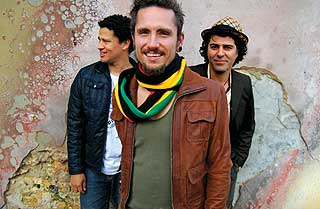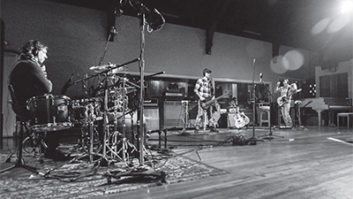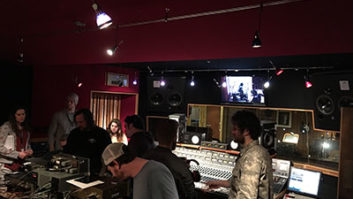
John Butler, flanked by Byron Luiters (left) and Nicky Bomba
Photo: Polly Armstrong
What are the odds that a singer/songwriter/guitarist from a small town near the Western Australian city of Perth—where 14 years ago he was busking on the streets—would develop an international following for his infectious and powerful amalgam of dancehall reggae, rootsy blues-rock, harmony-filled pop and Hendrix-influenced guitar pyrotechnics? The John Butler Trio (JBT) has been one of the biggest acts Down Under for a number of years, but evidently the word is spreading fast elsewhere: This month, the group is touring all over Europe in support of their new album, April Uprising, and then beginning in late May, they embark on a big U.S. tour that will find them headlining at Red Rocks in Colorado, hitting Bonnaroo and playing in a wide variety of clubs, theaters, ballrooms and amphitheaters.
In America, Butler is principally known for the albums Sunrise Over Sea (2004) and Grand National (2007), but there’s no doubt that April Uprising is going to increase his U.S. profile considerably. The eclectic 15-song disc is probably the JBT’s most “commercial” outing yet (whatever that means in this era), easily incorporating tuneful love songs and socially conscious numbers, fast riff-rockers and quiet ballads. It’s tough to pigeon-hole, but the songs are united by Butler’s strong presence as a singer and guitarist.
The current trio has only been together since last year: Bassist Byron Luiters replaced longtime JBT member Michael Barker, and drummer/percussionist Nicky Bomba is in the slot formerly occupied by Shannon Birchall, though Bomba (who is also Butler’s brother-in-law) was actually in the trio briefly before Birchall. “At the time we were making this trio, I was looking for a very heightened sense of chemistry, some kind of X-factor,” Butler says in early March as his tour bus cruises up the California coast from San Diego to San Francisco. “Nicky and I have a very special thing that dates back a long way, so we were looking for the same thing from Byron, and I think we found it. They’re both amazing musicians, and our catalogs and libraries overlap really well. We like a lot of the same things and we approach music the same way. When you find this kind of chemistry, it’s unquestionable—when you get it right, it feels like you’ve been playing with each other for 50 years.”
Adding to the group’s comfort level is the fact that they eschewed recording in a conventional studio and instead set up shop in Butler’s rehearsal space in Fremantle (12 miles south of Perth), enlisting engineer Robin Mai—who mastered the first JBT album and tracked and mixed Sunrise Over Sea—to record and mix April Uprising.
“I bought a building in Fremantle around three years ago with the idea of having a headquarters—an office and rehearsal room and a storage place,” Butler says. “We worked up most of the songs in the rehearsal room, and they turned out so well, Nicky was saying, ‘We’d be crazy to record somewhere else. You just need to do a couple of things to the room.’ So I got a bit of advice from some engineer friends and built a soundproof monitor [control] room within the big room to put the desk and the amps and the preamps in, and also be big enough so that I can be in there recording my acoustic guitar at the same time we track the drums. We put in these big sliding doors and a couple of gobos with windows so I could even isolate myself within that room and get a tighter sound. Then the main room, which is the drum room, is all jarrah [eucalyptus] floors but with big Persian carpets, so you can change the sound in different parts of the room. And we built a few more gobos so we can tighten or loosen the drum sound.

April Uprising was recorded in John Butler’s rehearsal space in Fremantle, Australia.
“Then, upstairs is where Nicky and Byron and Robin lived the whole time we recorded. It was very much like the Blood Sugar Sex Magik kind of situation [referring to the Rick Rubin–produced Red Hot Chili Peppers album that was recorded while they all lived together in a mansion]. It ended up being a great place to work and a great way to work.”
As for engineer Mai, “He’s the perfect combination of a lot of different qualities,” Butler says. “He has golden ears. He gets the warmest and most beautiful midrange. He also has great ears for tuning and timing. And he’s also very patient. I do a lot of production or co-production with the band, and he’s the perfect natural character who can put in his opinion while still letting us have our own process.”
The admiration is mutual. “They’re all such good players, full of great ideas and really fun to work with,” Mai says from Australia. It was Mai who selected most of the gear for the recording and was instrumental in setting up the rehearsal space as a studio. “It was an adventure,” he says with a laugh, “but it ended up working really well. It was nice and roomy. It felt like home to the boys; a very bohemian atmosphere. It wasn’t sterile in any way. John wanted it to sound ‘warm,’ and I think we achieved that.”
Though the control room was equipped with a 24-channel Toft Audio Design console, for the recording of April Uprising, Mai and the group elected to bypass the desk for the most part and instead recorded through top-quality mics and outboard gear directly to Pro Tools, using a Mackie console for monitoring. Included in the outboard racks were Neve 51 Series EQs, and Vintech, API, Millennia and Avalon mic pre’s (as well as three from the Toft desk).
In addition to being a versatile singer (whose vocals were mostly captured using a Gunter Wagner U47), Butler is also an exceptional and highly original guitarist whose sound incorporates both acoustic and electric textures—often at once. It wasn’t until I saw him perform live that I fully appreciated the fullness of his playing—especially with a slide—and the incredible sonic depth he achieves mostly using a single Maton 12-string acoustic guitar, fed simultaneously through a Marshall amp and a clean amp, with an array of pedals and, at times, an EBow. Additionally, Butler plays conventional electric guitar, banjo, resonator guitar and lap steel.
“His live setup is basically his studio setup,” Mai comments. “He has both a clean amp and the Marshall box going. We put two mics on the acoustic—the 47 and a [Neumann] KM84—and then we had a DI, a [Shure] SM57 and a [beyerdynamic] M88 on the Marshall, and a Royer 121 on the clean amp, which was a Fender Deluxe, the same amp he uses live.”
“A lot of the album is the acoustic 12-string with the Marshall going at the same time,” Butler adds. “I’m driving a Marshall through a volume pedal in another room: There’s a huge bathroom that we connected to the studio—we put a wall down the middle of it—and that became the amp room for my Marshall and my clean amp. What I can do is completely control the distortion I want on the guitar. If I want, I can just put a little ‘hair’ on the acoustic, or I can bring it in [the Marshall] and completely annihilate it! [Laughs] So that setup is always happening. But then what I might do is put a straight electric guitar on top of it; like on ‘To Look Like You,’ I did the solo live with the band and it sounded great, then I got an electric and mimicked the whole solo again on that. So it has the acoustic-electric going; then it has the acoustic through the Marshall with a whammy pedal that delays; and then there’s another electric guitar on top of that.”
The album is filled with neat touches—the Daniel Lanois-ish lap steel on the ethereal, atmospheric “A Star Is Born”; Bomba’s steel pans on “Take Me”; the subtle harmonium on “Ragged Mile”; the Fleetwood Mac–style vocal treatments on “I’m a Fool”—but it never sounds cluttered or overworked.
Mai, assisted by the group, mixed the album on an SSL 9k at Sing Sing Studios just outside of Melbourne, 1,700 miles from Perth. Butler calls it “pretty much the best studio in the country. It’s run by this couple, Kaj and Jude, who just love music, and Kaj has been collecting great old gear forever. We mixed it over about three weeks.”
“I like the depth and clarity of warmth of classic albums from the ’70s,” Mai comments. “I didn’t want it to sound plasticized; just real and emotional.”




